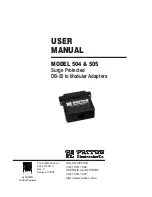
NOTE:
The Linux driver supports both Red Hat 3 and SUSE 8. See the
Readme file in the tar ball for information
on how to configure the Linux iSCSI initiator.
Assigning device names
Linux assigns SCSI device nodes dynamically when it detects a SCSI logical unit; therefore, the
mapping from device nodes (such as
/dev/sda
and
/dev/sdb
) to iSCSI targets and logical units
may vary.
Variations in process scheduling and network delay can result in iSCSI targets being mapped to
different SCSI device nodes each time the driver is started. Therefore, configuring applications or
operating system utilities to use the standard SCSI device nodes to access iSCSI devices can result in
SCSI commands being sent to the wrong target or logical unit.
To ensure consistent naming, the iSCSI driver scans the system to determine the mapping from SCSI
device nodes to iSCSI targets. The iSCSI driver creates a tree of directories and symbolic links under
/dev/iscsi
to facilitate access to an iSCSI target's logical unit.
The directory tree under
/dev/iscsi
contains subdirectories for each iSCSI bus number, each target
ID number on the bus, and each LUN for each target. For example, the disk device for bus 0, target
ID 0, and LUN 0 would be
/dev/iscsi/bus0/target0/LUN0/disk
.
Each logical unit directory contains a symbolic link for each SCSI device node that can connect to
that logical unit. The symbolic links are named using the Linux
devfs
naming convention.
•
The symbolic link
disk
maps to the whole-disk SCSI device node (for example,
/dev/sda
or
/
dev/sdb
).
•
The symbolic links,
part1
through
part15
, map to each partition of the SCSI disk. For example,
a symbolic link can map to partitions
/dev/sda1
and
dev/sda15
, or to as many partitions as
necessary.
NOTE:
The symbolic links exist regardless of the number of disk partitions. Accessing a partition name
results in an error if the partition does not exist on the disk.
•
The symbolic link
mt
maps to the auto-rewind SCSI tape device node for the LUN (for example,
/dev/st0
). Additional links for
mtl
,
mtm
, and
mta
map to the other auto-rewind devices (for
example,
/dev/st0l, /dev/st0m, /dev/st0a
), regardless of whether those device nodes
exist or can be opened.
•
The symbolic link
mtn
maps to the no-rewind SCSI tape device node, if any. (For example, this
LUN maps to
/dev/nst0
.) Additional links (
formtln
,
mtmn
, and
mtan
) map to the other no-
rewind devices (for example,
/dev/nst0l, /dev/nst0m, /dev/nst0a
), regardless of
whether those device nodes exist or can be opened.
•
The symbolic link
cd
maps to the SCSI CD-ROM device node, if any, for the LUN (for example,
/dev/scd0
).
•
The symbolic link
generic
maps to the SCSI generic device node, if any, for the LUN (for example,
/dev/sg0
).
The
symlink
creation process must open all SCSI device nodes in
/dev
to determine which nodes
map to iSCSI devices. Therefore, several
modprobe
messages may be logged to
syslog
indicating
MPX200 Multifunction Router
75
Summary of Contents for Storageworks 8100 - enterprise virtual array
Page 20: ...20 ...
Page 30: ...MPX200 Multifunction Router overview 30 ...
Page 47: ...Figure 27 iSCSI controller options Remove controller MPX200 Multifunction Router 47 ...
Page 48: ...Managing the MPX200 using HP Command View EVA 48 ...
Page 59: ...Figure 32 Virtual disk properties Figure 33 Host details MPX200 Multifunction Router 59 ...
Page 112: ...MPX200 iSCSI configuration rules and guidelines 112 ...
Page 219: ...Load Balancing Enabled Array License Not Applied MPX200 Multifunction Router 219 ...
Page 248: ...Offline Data Migration 248 ...
Page 258: ...Diagnostics and troubleshooting 258 ...
Page 306: ...Command referencecommand reference 306 ...
Page 330: ... Blade number 1 or 2 Simple Network Management Protocol setup 330 ...
Page 368: ...Saving and restoring the MPX200 configuration 368 ...
Page 402: ...Data migration best practices 402 ...
Page 408: ...408 ...
















































